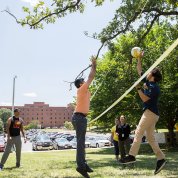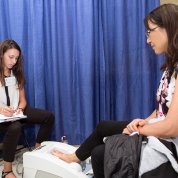For Your Health
NIH Expo Celebrates Safety, Wellness
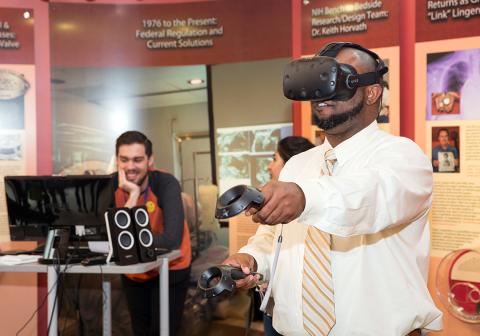
Photo: Chia-Chi Charlie Chang
For all that NIH’ers do to advance the health of others, it was invigorating for staff to have a day to reflect on their own health and have some fun in the process.
Hundreds of employees stopped by the Clinical Center’s south lobby and lawn on June 28 for the 6th annual Safety, Health & Wellness Day, coordinated by ORS, ORF and R&W. Some enjoyed a rejuvenating chair massage. Others gathered around the volleyball net for a friendly game.
The ideal weather allowed for more activities to take place outdoors, including judo demonstrations and exercise classes, from yoga and Pilates to Zumba. The NIH Fitness Center’s LaTanya Richards, who led a line dancing class, said any type of organized dance can provide great exercise. “Just keep moving and have fun!” she said.
Many NIH’ers stopped by dozens of exhibits to learn something interesting. So that’s what a whole jicama looks like? Eurest Dining Services featured a Guess the Produce game and demonstrated creative ways to work more vegetables into meals, such as making “zoodles” and using crumbled cauliflower instead of rice.
Some staff took the opportunity to get free health screenings, each of which took just a few minutes and provided instant results. Stations were set up to test vision, bone density and skin damage.
Lynn from NIAID came from her off-campus office for the elder/adult dependent care resources. “I came specifically for this fair and found very useful information,” she said.
Don’t Bypass This
This year’s IC co-sponsor, NHLBI, provided hearty recipes and health resources, with experts on hand to discuss current research. Dr. Larry Fine, chief of NHLBI’s Clinical Applications & Prevention Branch, showed a model of a human heart’s arteries to illustrate the dangers of plaque buildup.
“Good lipids and blood pressure and a healthy weight can prevent or delay plaque buildup,” said Fine. “[When excessive plaque clogs arteries], a catheter can remove plaque, restore blood flow and limit danger; this is a modern treatment.”
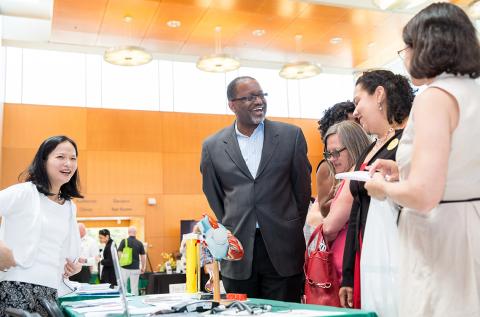
Photo: Chia-Chi Charlie Chang
Heart disease has decreased dramatically in recent decades due to prevention—exercise, not smoking—and modern medical treatment. “Epidemiology studies have helped,” said Fine, “but we still have a long way to go. We’re not at zero yet.” Ongoing clinical trials include studying the effects of stress and other psychological factors that cause premature cardiovascular death.
There’s another area of NHLBI research helping put our minds at rest. New data supports earlier findings that getting enough sleep bolsters our immune system.
“New research shows poor sleep affects stem cells,” said Dr. Michael Twery, director of NHLBI’s National Center on Sleep Disorders Research. “If you interfere with the rhythm of hematopoietic stem cells, you produce fewer immune cells and fewer red blood cells.”
NHLBI director Dr. Gary Gibbons dropped by his institute’s exhibit and shared some healthful advice. “There are simple steps we can all take, easily and inexpensively—more walking, being active, eating more fruits and vegetables and smaller portions—that will help us live longer,” he said. NHLBI is working with other ICs on a variety of collaborative efforts, he added. “We’re all in this together.”
Staying Safe
NIH’ers learned all kinds of tips to keep safe at work and home. Brett Beall from the Occupational Safety & Health Administration shared campaign materials on beating the heat, avoiding chemical hazards and preventing accidents. “We work for all federal employees to ensure their safety and rights,” he said. “Many tips apply to home safety too.”
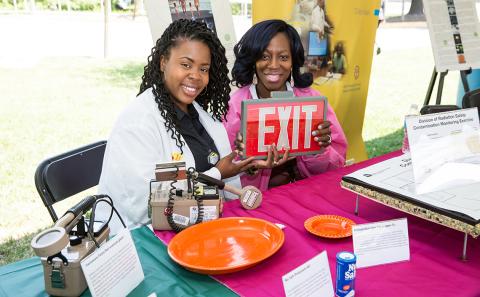
Photo: Chia-Chi Charlie Chang
Ever have concerns about air quality in your office? NIH’s Division of Occupational Health & Safety exhibited some of the tools they use to gauge mold, mildew, leaks and other hazards. If there’s a health hazard, they’ll send in technicians to make repairs.
Safety, Health & Wellness Day originated as a lab safety fair for scientists, said ORS’s Antony Schwartz, who helped organize the event. But it quickly expanded to encompass health and wellness with relevant information and activities for all NIH’ers. Previously held in Natcher Bldg., this is the second year the expo was held in the CC, which Schwartz said has greatly expanded its visibility.
Just about everyone came away with some handy wellness tips; the lucky ones also came away with more relaxed shoulders.

